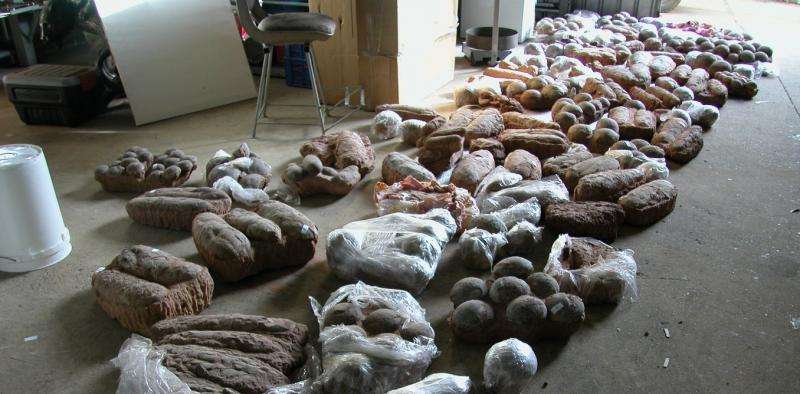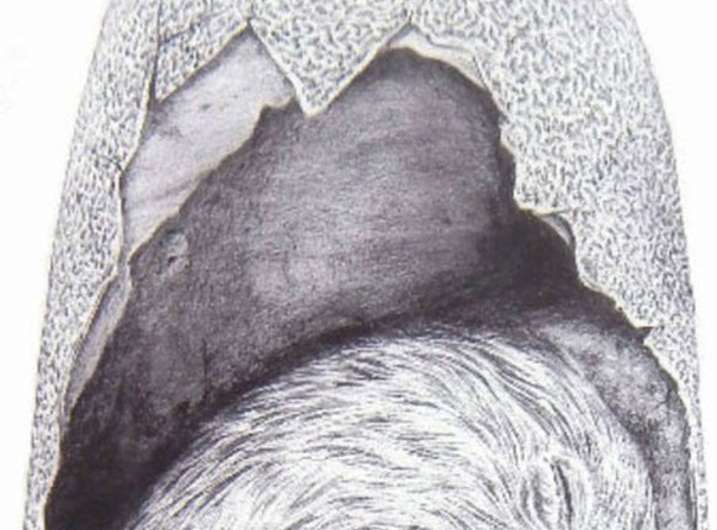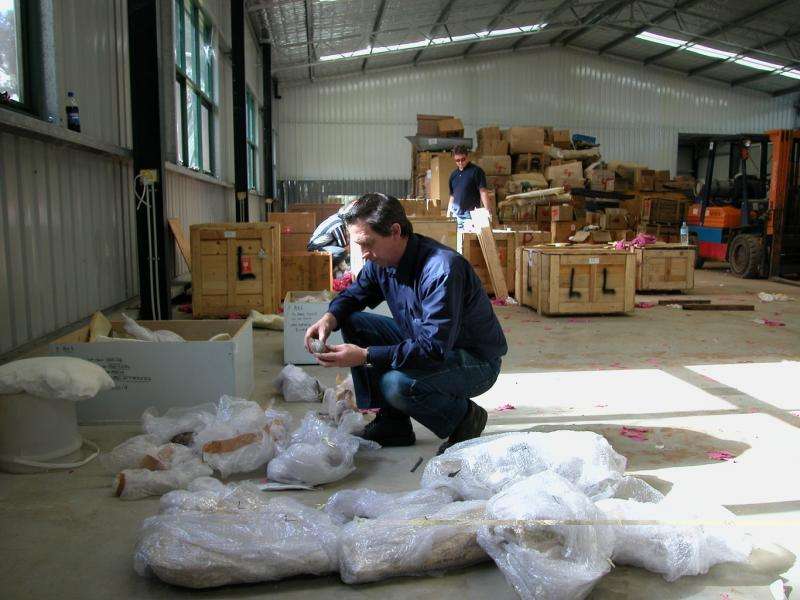Dinosaur embryo returned to China, but many fossils fall victim to illegal trade and poor protection

China's record of life's past history on Earth is second to none.
The country is famous especially for the excellent preservation of the 130 million year old feathered dinosaurs and early birds from Liaoning Province. These specimens have reframed the narrative about how birds evolved from theropod dinosaurs.
China has also long been famous for its abundance of fossil dinosaur egg localities.
A recent study just published reveals that a well-preserved nest of the largest known dinosaur eggs, called "Macroelongatoolithus" from Henan Province, contains a complete skeleton of a dinosaur new to science, Beibeilong.
It's a case that brings a stark reminder that incredible scientific findings rely not only on careful and ethical research activities among scientists across the world, but also on governments that value scientific heritage.
New dinosaur revealed in returned fossil
The Macroelongatoolithus fossil, first uncovered back in late 1992 or early 1993, became famous when it made the cover of National Geographic magazine in 1996, and the baby dinosaur was dubbed "Baby Louis" after photographer Louis Psihoyos.
The new research links this 23cm long curled dinosaur embryo to a strange clade of dinosaurs named caenognathids. It is new dinosaur, named Beibeilong, meaning "baby dragon".
The adults of this group were large, toothless forms with short curve beaks, perhaps best represented by closely related forms like Oviraptor. They looked more like giant zombie parrots than your run-of-the-mill dinosaur.
Other oviraptosaurs have been found in China with complete coverings of feathers on the body, and sporting large expanded tail feathers (Caudipteryx).
Beibeilong had a stretched out "snout to vent" (that is, from nose to base of the tail) length of 38cm, making it a very big embryo. The eggs it came from are among the largest known of all dinosaur eggs, measuring up to 45cm in length.
Beibeilong would therefore have been among the biggest of the caenagnathid dinosaurs, and like its close cousin Gigantoraptor, may have reached sizes of around 8 metres and weighed up to 1,400kg. They were less terrifying than other theropods, being omnivores feeding on seeds, plants and occasional small animals.
Not just another dino story
Yet there is more to this story than just another new dinosaur discovery.

It was and still is illegal to export Chinese dinosaur fossils.
In 2003 the famous "Baby Louis" fossil was acquired by the Indianapolis Children's Museum in the US, imported through The Stone Company, which dealt with the sale of fossils. The museum had an agreement with China that it would repatriate the fossil after a period of display, and this agreement was finalised in late 2013, when the fossil made it home to Henan Province.
Canadian dinosaur expert Phil Currie and his team went back to China to track down where the fossil had originally been found. They found the farmer who discovered the specimen, and were able to find other egg fragments that matched the original specimen to confirm its locality.
This story had a happy ending but it is reminiscent of another side to the fossil business. In those days, many Chinese fossils were being smuggled out illegally to markets in the US, Germany, Japan and other countries who were not part of the UNESCO convention agreeing to repatriation of other country's cultural heritage items.
In 2002 I wrote a book outlining these issues, and stating case studies of the international illegal fossil trade. Penalties were extremely harsh in China.
In 1995 three Chinese men caught trying to sell 16 dinosaur eggs were sentenced to five and half years imprisonment. At the time there were many shops in Australia openly selling Chinese dinosaur eggs. It had to be stopped, so I was brought in to assist both local police units in some states, and the Australian Federal Police (AFP) to advise them.
How we stopped the illegal fossil trade in Australia
It was dark, well before sunrise, on a cold June day in 2004, when a fleet of AFP cars came to pick me up.
A large haul of suspected illegal fossils was identified at a private residence south of Perth, so I had been brought in as the expert witness and fossil identifier. It was crucial to know with 100% certainty if the fossils represented species from Australia, which meant no crime had been committed, or if they were smuggled in from China, where it is against the heritage laws of the country to export certain fossils.
At the time the Chinese government had made a request to Australian officials to specifically crack down on illegal Chinese fossils being sold in Australian fossil shops.
The dawn raid went well. The warehouse had many large packing crates, piled on top of each other from floor to ceiling. I spent all that day opening crates, examining and photographing the fossils.
That night I sent many images to my palaeontological colleagues in China to obtain confirmation that every specimen we unpacked belonged to species only found in China.
This totally nailed the case for the AFP. Even the wrapping paper provided good evidence for the case, as each fossil was wrapped in Chinese newspapers giving approximate dates and specific provinces of the wrapping event.
About A$6 million dollars worth of illegal chinese fossils were seized that day.

In 2008, after the AFP had finished with the evidence, the whole collection was handed back to China at a ceremony at the Chinese Embassy in Canberra.
The vast collection – including superb dinosaur eggs, dinosaur skeletons, many fossil rhinoceros and sabre-tooth cat skulls, exquisite complete fish fossils, and beautiful long-necked marine reptiles – was all handed back to Chinese officials in Canberra, at the Chinese Embassy. To show their gratitude for our efforts, the Chinese government gave a gift of several important Chinese fossil specimens to two Australian museums.
After this case was heavily publicised, the illegal importing of fossils from China was stopped in Australia. The threat of large fines or jail sentences for illegal fossil imports reinforced how seriously the government views these offences.
In the case quoted above, the importer of the fossils pleaded he knew nothing about the illegality of importing Chinese fossils. In a show of mercy he was neither fined nor prosecuted. Instead, he lost several million Australian dollars worth of fossils which he had purchased and imported.
Few illegal fossils have been detected for sale in this country since then.
New threats to protecting fossil sites
In recent years new threats to the protection of significant fossil sites are emerging, and this time it's not from illegal activity.
Donald Trump recently issued a Presidential Executive Order to "review prior national monument designations and propose changes or modify or rescind lands".
One under threat is Bears Ears National Monument in Utah. Aside from its very significant cultural value to some 30 Native American peoples, the area contains very important fossils sites that could suddenly be open to unwanted exploitation by amateur fossil hunters or commercial dealers.
Many vertebrate fossil discoveries already made in the area are the only examples of their kind in the USA or the world, including new species of extinct fish, amphibians, mammal-relatives, and reptiles.
President of the Society of Vertebrate Paleontology, Dr David Polly has said in a private correspondance:
"Legal regulation has become key for ensuring that paleontologists can continue discovering the history of life on Earth. The few protections that are in place in the US are currently threatened by reviews of public lands, such as at Bears Ears and Grand Escalante Staircase National Monuments."
In addition, the threat of development over highly significant fossil sites here in Australia is not to be overlooked. One such case is the internationally famous Beaumaris Fossil sites in Melbourne, currently under threat of being built over by a proposed marina. A proposed dam at Cranky Rock near Orange has also been raised as a potential threat to fossils at Cliefden Caves.
Fossils are a part of our natural and cultural heritage. They tell a story that we all need to hear - how we evolved, and where we are heading as a species.
It's my opinion that we must stand up against development and legislation that could result in the desecration of internationally significant fossil sites, and the potential loss of unique scientific specimens.
Provided by The Conversation
This article was originally published on The Conversation. Read the original article.![]()



















